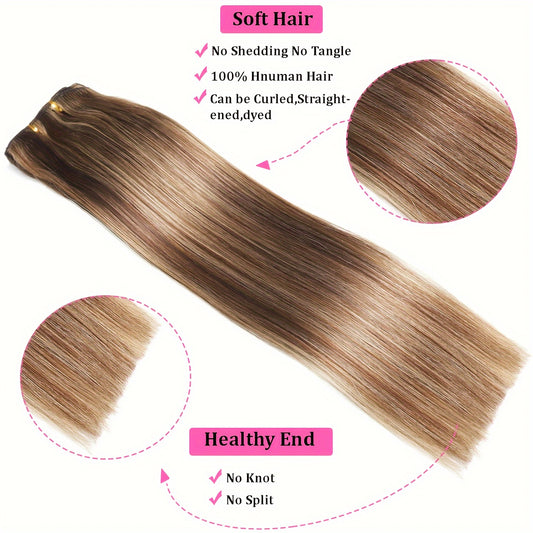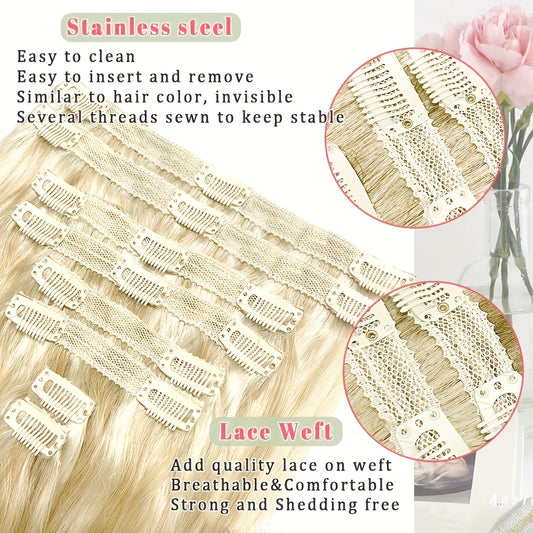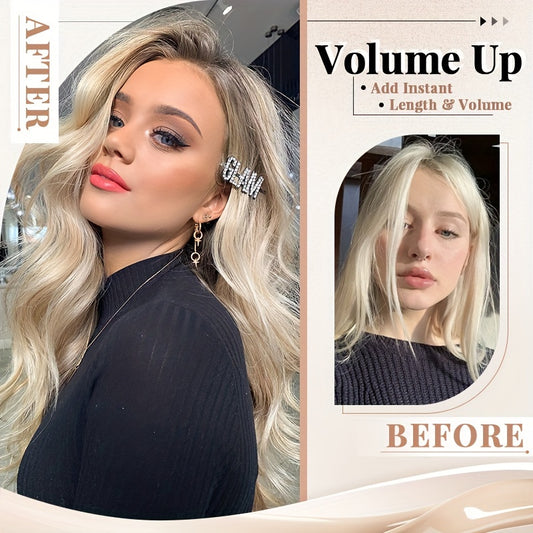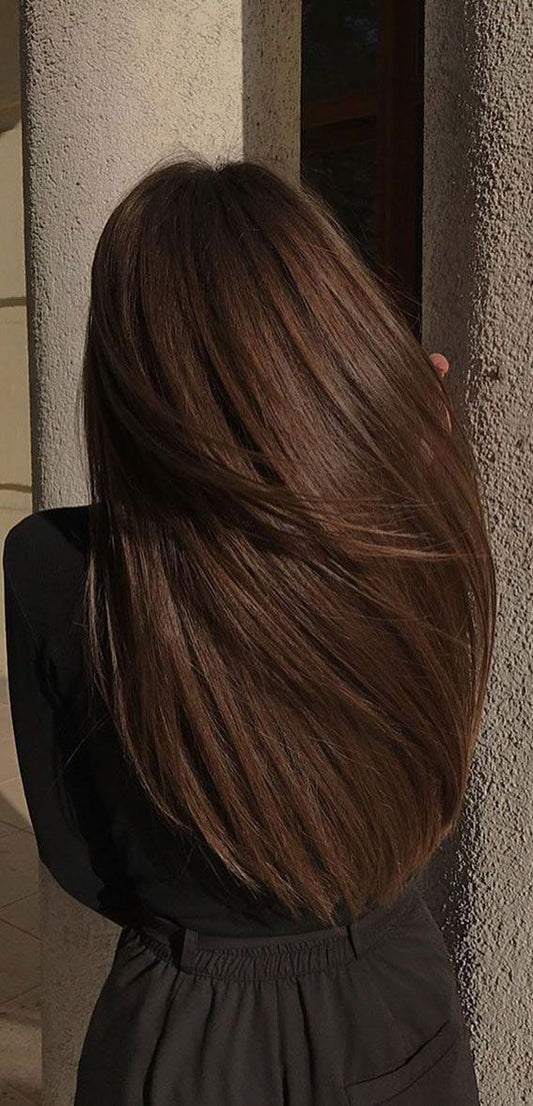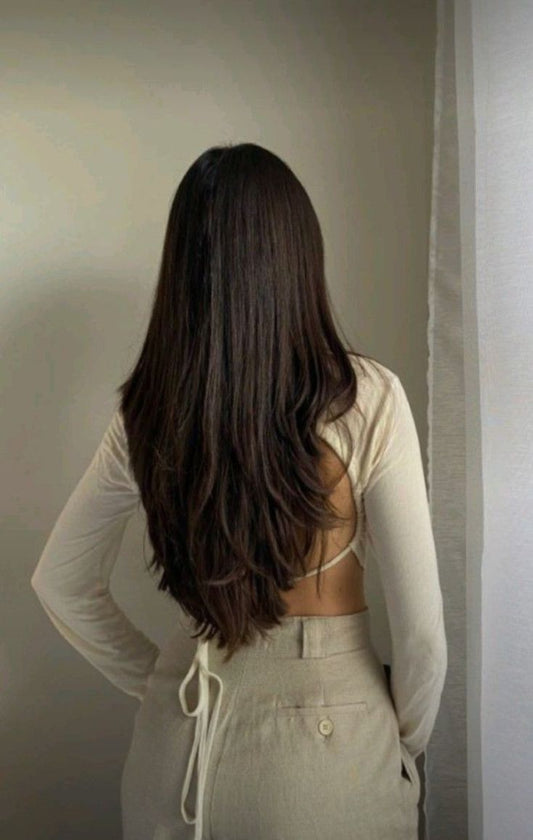About 26 Inch Clip In Hair Extensions
What the length looks like on the body
On many frames, a true 26 inch straight finish reaches the waist; on shorter torsos it can read lower. With loose bends it reads closer to twenty four visually, and with uniform curls it can read near twenty three. This is a geometry effect, not a defect. Jackets, seat belts, bag straps, and chair backs touch the hair frequently at this length, so a realistic routine includes one midday brush and a micro drop of serum on mid lengths and ends only. Keep roots free of oils because clips grip best on clean texture. The crown layer—the top hair that hides the clips—is your concealment budget; protect it by avoiding high placements.
Cameras judge the bottom third first. A foggy hem makes the whole style look underbuilt even if the top is polished. A confident, squared edge makes the mind read the entire look as premium. That difference comes from grams, end draw, and placement—not from heavy products.
Who chooses twenty six inches
Wearers who want ultra long hair that reads as a feature on camera choose this length. Creators and performers use it for long wave sheets, braid work, and sleek silhouettes that feel cinematic. Event guests pick it when a dress or suit wants a length that carries through the frame. Some everyday users simply enjoy the proportion. All benefit from the same controls: correct grams, a clean map, daylight color matching, and small habits that prevent friction damage at the ends.
If your natural hair is above the cheekbone, the top layer may not cover hardware reliably; a halo or a shorter set can bridge the gap while you grow. If your natural hair is very dense and blunt, you will likely need higher grams and double drawn ends for straight finishes. If a daily high ponytail is non negotiable, standard clip maps will flash; down styles, half ups, and low buns are the optimized use cases for clip ins at this length.
Grams planning
Grams are the single most important variable at 26 inches because the camera fixates on the last third of the outline. Use a simple ladder. Ninety to one hundred twenty grams: subtle fullness and improved ends for fine, layered natural hair, best in soft waves. One hundred thirty to one hundred sixty grams: everyday full head that photographs dense while feeling light; default for many buyers. One hundred seventy to two hundred forty grams: plush hem for blunt cuts, thicker strands, studio lighting, or humid climates where waves relax. Above two hundred forty grams: specialty setups for very dense natural hair or crisp straight looks under hard light.
Map weight to haircut and goal. Blunt shoulder or collarbone cuts need higher grams so extension hair meets the line without a shelf. Layered shoulder length can run on medium grams because layers hide joins. Fine mid lengths often do best with a medium set plus two narrow temple boosters rather than over building the back. Thick tapered hair balances the silhouette with one heavy back row and one medium row rather than many light pieces near the crown. Choose grams for the photo you want: graphic straight edge needs more than romantic wave.
End draw and edge design
Single drawn hair tapers toward the tips and looks like organic growth. It brushes into motion easily and loves waves. Double drawn hair carries density into the lower third and reads like a fresh haircut—square, calm, and premium in straight or beveled finishes. At 26 inches, double drawn often photographs as more expensive because the hem occupies more of the frame. Neither is mandatory. If only single drawn is available, a micro trim of half an inch to one inch converts a soft taper into a firmer line without sacrificing the idea of ultra long length.
Proof beats adjectives. A cropped back view of the ends at rest in daylight tells the truth about density faster than any sentence. If the page does not show the hem, request that photo before choosing grams.
Texture selection by routine
Straight texture creates the longest visual drop and supports exact geometry. It also shows friction faster, so brushing and heat discipline matter. Body wave is the universal blender: one low heat pass brushes it smooth; a single set with full cooling becomes plush curves. Loose curl and deep wave arrive with pattern and are easiest to blend when the coil diameter is close to your own hair. Coily options should be labeled by diameter and shrinkage, with proof photos of defined and brushed out states so behavior is predictable.
Choose texture by daily habit. If you blow out most days, straight works. If you alternate smooth days with bend days, body wave saves time. If you live in curls, match coil scale so the join disappears. The right choice reduces passes and products; it is an effort decision rather than a label.
Color match logic
Match undertone first—cool, neutral, warm—then match depth. Verify in daylight by a window; bathroom bulbs skew yellow or blue and can fool the eye. If you sit between shades, slightly lighter is safer because human hair accepts cooling or deepening with demi toners; lifting lighter raises cuticles and shortens life. Rooted and balayage options hide seams at parts and temples and help darker roots blend. Take a quick daylight photo of your match and save it for reorders; device screens and lighting change, your photo does not.
Edge cases respond to small moves. Cool brunettes that read warm indoors should trust daylight or add a brief cool glaze. Warm brondes that swing between sunlit caramel and indoor beige benefit from a soft root. Deep browns with red cast should start neutral and tone cooler in small steps. For gray blending, start with neutral gray and tune with violet only as needed.
Material standards that matter
True Remy human hair—cuticles aligned in one direction—reduces friction, resists matting, and reflects light softly instead of glaring. With aligned cuticles you can style with moderate heat and expect predictable results: one slow pass to smooth, curls that hold after cooling, and wash cycles that do not roughen the surface quickly. Heavy silicone masking can look perfect out of the package and then wash off unevenly. Prefer minimal processing and clear statements about toning tolerance so you can tune color safely later.
At extra long length the hem is the product. Cuticle integrity is the reason the edge remains believable through events, travel, and repeated brush outs. Material quality and small habits, not heavy product, keep 26 inches looking intentional.
Clip map for twenty six inches
Detangle natural hair and wefts. Section above the nape and anchor the widest weft with the center clip first, then the sides. Move up one row by about a finger to an inch and place the next widest weft where the head begins to curve. Add medium wefts along the occipital arc to build structure. Place narrow pieces at the sides to fill the temples and complete the face frame. Keep the crown layer generous; it hides seams during wind and head turns. Tease very lightly where clips will sit and mist a small amount of flexible spray for grip. Keep roots product free.
At this length add a slim cover weft one step higher on each side as wind insurance. It disappears under the crown layer and prevents flashing when doors open, cars pass, or you turn quickly on camera. Smart coverage beats adding many pieces near the crown.
Blending and finishing
Cap tools at or under one hundred eighty Celsius or three hundred fifty Fahrenheit. One slow pass gives more polish than three fast passes. Allow each curled section to cool fully before brushing into a single pattern; cooling sets the shape you created. Apply flexible spray to the brush, not directly to the hair, to preserve sheen. Finish with a pea of serum on mid lengths and ends only. For straight looks, bevel the final half inch to one inch; that micro curve makes the hem read like a fresh cut.
If the bottom line still looks soft in straight photos, schedule a half inch trim. If the top looks flat, over direct crown sections during a blowout, let them cool, then lay them back; the lift appears without teasing. Small adjustments are the difference between okay and excellent.
Wind and movement strategy
Wind exposes seams when the crown layer is thin or when a part sits directly over a row. Keep the crown layer ample. Shift the part a few millimeters if a line wants to show. Use the slim cover weft higher on breezy days. For transitions between buildings, deploy a temporary ear tuck and release it inside. In cars, sweep hair over one shoulder and brush once after arrival. Under hats and hoods, map rows slightly lower and tuck front sections behind the ears before pulling the hat down, then release.
Choose smooth strap bags and avoid hook and loop closures near the ends. Zip jackets slowly while hair is forward; release it after the zipper settles. These unglamorous moves protect the hem better than any product trick.
Comfort and ergonomics
Comfort comes from distribution. Spread weight across rows; do not stack near the crown. Support the weft with your free hand while brushing to avoid torque at seams. Rotate exact clip positions a few millimeters between wears so the same follicles do not carry all the load. If your scalp feels tender, remove one piece for everyday use and add it back for events. For very fine hair, a halo can carry length for long days with almost no root stress.
Long hair also changes micro movements: sit first and sweep hair forward; close car doors and seat belts with hair placed to one side; brush before and after outerwear. Ergonomics is style insurance.
Daily rhythm
Morning: brush natural hair and wefts, install using the map, set shape with low to moderate heat, allow full cooling, brush once into final pattern, and make one ear tuck for motion control. Midday: if you wore outerwear or sat against a chair back for long stretches, brush once. Evening: brush, remove clip ins, and coil wefts in a gentle U in a satin pouch away from heat and humidity. Weekly: wash based on wear and product load; clarify only when necessary; air dry as far as possible; keep temperatures capped.
Do not sleep in clip ins. Avoid stacking pieces high on the head where the top layer thins. Maintain a note with your shade code, grams, texture, and tool settings; repeating the same setup makes results quick and reliable.
Troubleshooting quick list
Weft flash in wind or bright light: top layer is too thin or the part sits over a seam; shift the part, add a higher cover weft, or lower the row at the next install. Ends read wispy in straight photos: request a half inch trim or choose double drawn next order. Nape tangles under coats and straps: reduce heat for a week, hydrate ends, and brush after removing layers. Clip slip on fine hair: clean clip teeth, add a light root texture spray, and avoid freshly conditioned anchor zones.
Color looks right outside but too warm indoors: trust daylight; if needed, apply a short cool toner. Tender roots: reduce piece count, vary placement a few millimeters each wear, and add rest days. Too much shine on camera: spray the brush with flexible hold and sweep once rather than spraying hair directly. Most issues respond to small, calm adjustments.
Event plan and travel
Event day: set curls or bevel ends early, let everything cool fully while you finish makeup, brush into one pattern, and sweep once with flexible spray on the brush. Pack a small kit with a loop brush, a few bobby pins, flexible spray, a pea of serum, and two spare clips. For outdoor events, plan one ear tuck and a part shift option to handle gusts without fuss.
Travel day: store wefts brushed and coiled in satin; on arrival, hang for a few minutes to relax; refresh with a light mist and a quick brush. Cabin air is dry; use only a tiny drop of serum on the ends so mid lengths do not attract dust. Sweep hair forward during long rides and brush once at your destination.
Product page elements that help buyers
A clear collection page starts with the exact length and method in the title, shows each shade in daylight from front, side, and back, and includes a cropped end shot at rest. One simple line states where twenty six inches lands on the body and typical install time. Filters allow selection by grams, texture, and shade family. Tiles list grams and texture and a tiny cue like everyday density or glam hem. A compact three step diagram—section, anchor, blend—sits within one scroll of the hero.
FAQ covers heat caps, washing cadence, return basics for unopened hair, and an undertone note. A small color assist reminder near swatches prompts daylight checks. Every sentence is a decision aid, not filler.
Accessibility and localization
Pair shade names with numeric descriptors such as level 6 neutral brown so color blind shoppers can map values. Provide alt text that includes length, texture, undertone, and draw. Ensure filter controls are keyboard accessible and that changes are announced to screen readers. Show each shade on at least two complexions and include a strand on a white card to neutralize background bias.
Use both inches and centimeters for length and keep grams consistent. Publish realistic shipping windows and customs notes. Offer support hours that cover several time zones with a clear reply time. Clarity moves visitors from curiosity to purchase without friction.
Safety boundaries
Do not sleep in clip in hair extensions. Do not set tools above the recommended temperature. Do not put heavy oils at the roots; anchors depend on clean texture. Do not attempt to lift color lighter on extensions; tone darker or cooler instead. Do not stack too many pieces near the crown where the top layer is thin. If you have a scalp or skin condition, consult a professional before choosing a method. These guidelines are guardrails that protect comfort and lifespan.
If a step feels complicated, slow down and return to the rhythm: section, anchor, blend, cool, brush. That small system solves nearly everything without noise.
Value and ownership
Removable systems managed with moderate heat, complete cooling, and satin storage can last months. Cost per wear compares favorably to frequent single appointment services, especially for people who appear on camera or attend regular events. Time saved is its own value: a repeatable five to ten minute install replaces travel and waiting for a chair. Brands that publish grams calculators, daylight end crops, and honest heat caps reduce mismatches and returns, which stabilizes prices and reduces waste.
Ownership gets easier when you keep records. Shade code, grams, texture, and tool settings turn a good hair day into a template you can repeat without thinking. Predictability is the quiet luxury of a well planned setup.
Glossary
Grams: total hair weight in the set; controls end fullness. Draw: end distribution—single tapers, double stays thick. Weft: a horizontal strip of hair; clip in sets use multiple wefts with small clips. Cover weft: a slim piece placed higher to hide joins. Occipital: the back curve of the head where medium wefts sit. Perimeter: the visible outline at the ends. Rooted: slightly deeper tone at the top to blend parts. Balayage: gradual lightness through lengths to soften seams.
Cooling rule: let hot hair cool before brushing so the shape sets. Temple piece: a narrow panel near the temple to remove hollows and balance the face frame. Bevel: a small curve at the very ends that reads like a fresh cut in straight styles. Crown layer: the unwefted top hair that conceals hardware.
Summary
Twenty six inch clip in hair extensions deliver a dramatic, camera ready length that remains manageable when you plan grams, end draw, texture, color, and placement with care. Match color by undertone in daylight, keep tools moderate, allow complete cooling, and brush once to set the final pattern. Store brushed pieces in satin and rotate exact clip positions to protect comfort. With these small, repeatable choices, ultra long hair looks intentional instead of fussy and stays that way through travel, work, and events.
When in doubt, return to fundamentals: section, anchor, blend, cool, brush. Trust the daylight color check. Cap heat. Support the row while brushing. These simple behaviors do more for 26 inches than any heavy product routine ever will.
Use cases by routine
Office setups favor a beveled blowout or a sleek low pony that clears collars and headsets. Teaching or streaming reads best with brushed wave sheets because they stay coherent on camera. Weddings and formal events benefit from uniform curls brushed into a single pattern; the hair looks intentional from first look to last dance. Travel days work with a compact claw clip twist and a temporary ear tuck while moving; brush out on arrival and reset the outline with one pass of the brush sprayed lightly with flexible hold.
Pick one default daily pattern and one event pattern. Repetition makes results fast and consistent. Consistency is a silent style amplifier: it turns a long set into a reliable uniform rather than a project.
Use cases by routine
Office setups favor a beveled blowout or a sleek low pony that clears collars and headsets. Teaching or streaming reads best with brushed wave sheets because they stay coherent on camera. Weddings and formal events benefit from uniform curls brushed into a single pattern; the hair looks intentional from first look to last dance. Travel days work with a compact claw clip twist and a temporary ear tuck while moving; brush out on arrival and reset the outline with one pass of the brush sprayed lightly with flexible hold.
Pick one default daily pattern and one event pattern. Repetition makes results fast and consistent. Consistency is a silent style amplifier: it turns a long set into a reliable uniform rather than a project.
Use cases by routine
Office setups favor a beveled blowout or a sleek low pony that clears collars and headsets. Teaching or streaming reads best with brushed wave sheets because they stay coherent on camera. Weddings and formal events benefit from uniform curls brushed into a single pattern; the hair looks intentional from first look to last dance. Travel days work with a compact claw clip twist and a temporary ear tuck while moving; brush out on arrival and reset the outline with one pass of the brush sprayed lightly with flexible hold.
Pick one default daily pattern and one event pattern. Repetition makes results fast and consistent. Consistency is a silent style amplifier: it turns a long set into a reliable uniform rather than a project.
Use cases by routine
Office setups favor a beveled blowout or a sleek low pony that clears collars and headsets. Teaching or streaming reads best with brushed wave sheets because they stay coherent on camera. Weddings and formal events benefit from uniform curls brushed into a single pattern; the hair looks intentional from first look to last dance. Travel days work with a compact claw clip twist and a temporary ear tuck while moving; brush out on arrival and reset the outline with one pass of the brush sprayed lightly with flexible hold.
Pick one default daily pattern and one event pattern. Repetition makes results fast and consistent. Consistency is a silent style amplifier: it turns a long set into a reliable uniform rather than a project.
Use cases by routine
Office setups favor a beveled blowout or a sleek low pony that clears collars and headsets. Teaching or streaming reads best with brushed wave sheets because they stay coherent on camera. Weddings and formal events benefit from uniform curls brushed into a single pattern; the hair looks intentional from first look to last dance. Travel days work with a compact claw clip twist and a temporary ear tuck while moving; brush out on arrival and reset the outline with one pass of the brush sprayed lightly with flexible hold.
Pick one default daily pattern and one event pattern. Repetition makes results fast and consistent. Consistency is a silent style amplifier: it turns a long set into a reliable uniform rather than a project.
Use cases by routine
Office setups favor a beveled blowout or a sleek low pony that clears collars and headsets. Teaching or streaming reads best with brushed wave sheets because they stay coherent on camera. Weddings and formal events benefit from uniform curls brushed into a single pattern; the hair looks intentional from first look to last dance. Travel days work with a compact claw clip twist and a temporary ear tuck while moving; brush out on arrival and reset the outline with one pass of the brush sprayed lightly with flexible hold.
Pick one default daily pattern and one event pattern. Repetition makes results fast and consistent. Consistency is a silent style amplifier: it turns a long set into a reliable uniform rather than a project.
Customer reviews
- I chose 190 g for straight looks and the hem finally reads clean rather than wispy; waves last well past sunset when I let them cool before brushing. — Maya Bennett, New York, USA ⭐⭐⭐⭐⭐
- Daylight color matching pushed me to a neutral rooted shade; my part blends under both sun and office LEDs, and install is under ten minutes now. — Daniel Price, Toronto, Canada ⭐⭐⭐⭐⭐
- Sensitive scalp here and still comfortable using a lighter daily map with two extra temple pieces for events; spacing the clips a few millimeters apart helped. — Amelia Wright, London, United Kingdom ⭐⭐⭐⭐
- Body wave fits my routine because I switch between sleek bends and plush waves; the 26 inch outline photographs tidy and sits near my waist. — Olivia Turner, Sydney, Australia ⭐⭐⭐⭐⭐
- Two narrow side pieces erased temple hollows and a half inch trim made the straight edge look like a salon finish at this length. — Sofia Rossi, Milan, Italy ⭐⭐⭐⭐⭐
- Shipping was a day slow so one star off, but the Remy hair quality is obvious and the clips have real spring; install and removal are simple. — Harper Lewis, Chicago, USA ⭐⭐⭐⭐
- I present on Zoom and the long outline photographs smooth—no plastic glare, just a steady hem that survives long sessions. — Grace Johnson, Los Angeles, USA ⭐⭐⭐⭐⭐
- Windy outdoor shoot and the higher cover weft trick saved me; a small part shift plus an ear tuck kept everything invisible. — Hannah Evans, Manchester, United Kingdom ⭐⭐⭐⭐⭐
- First time at this length and the section–anchor–blend map worked on day one; I logged shade, grams, and tool temps for next order. — Chloe Martin, Vancouver, Canada ⭐⭐⭐⭐⭐
- I remove them for cycling and put them back for dinner; fewer tangles than expected at 26 inches and the hem stays sharp after one brush. — Charlotte Hall, Melbourne, Australia ⭐⭐⭐⭐⭐


